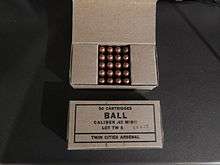Twin Cities Army Ammunition Plant
The Twin Cities Army Ammunition Plant was a United States Army ammunition plant located in Ramsey County, Minnesota in the current boundaries of the suburbs of Arden Hills and New Brighton, bounded by County Road I to the north, I-35W to the west, U.S. Route 10 to the southwest, County Highway 96 to the south, and Lexington Avenue to the east. The site had 255 buildings across 2,382 acres (9.64 km2).[1]. Current land redevelopment involves the removal of these buildings.


The site was added to the National Priorities List as a Superfund site on September 8, 1983.[2] The soil, sediments, groundwater, and surface water surrounding the plant were contaminated with base neutral acids, metals, polycyclic aromatic hydrocarbons, polychlorinated biphenyls, volatile organic compounds, pesticides, cyanide, and explosives.[2] These contaminants entered Rice Creek and from there the ground water in New Brighton.[3]
Initially, the plant was known as the Twin Cities Ordnance Plant but it was renamed the Twin Cities Arsenal in 1946 and finally, in 1963, the Twin Cities Army Ammunition Plant.[4]
History
The TCAAP was a product of the government-owned, contractor-operated (GOCO) war materials production program established by the War Department during World War II. The Minneapolis-Saint Paul area emerged as a potential GOCO candidate primarily on the basis of labor supply. TCAAP was one of six GOCO plants built to produce small arms ammunition during World War II, and was operated by the Federal Cartridge Corporation under contract to the War Department.[5]
Construction of the plant began in August 1941 and was completed with three main munitions facilities. Each main facility had five lines of production and the entire plant had a total of 35 lines.
The mission of TCAAP was to produce .30, .50 and .45 caliber ammunition. Production of small arms ammunition began on March 9, 1942, and the plant remained in production for 42 months. Between 1942 and 1945, TCAAP produced all five main small arms types: ball, armor piercing, tracer, incendiary, and blanks. In 1944 the plant opened an important small arms ammunition reclamation center. The design of the .30 and .50 caliber cartridge-disassembly machines by TCAAP personnel in the late 1940s represented a significant technological advance in small arms salvage technology. Development in ammunition salvage begun during World War II continued at the facility during the Cold War period. The work force reached its peak in July 1943, when employment totaled about 26,000 people, more than half of whom were women.
After Victory over Japan Day, Twin Cities Ordnance Plant was placed in reserve status and "mothballed". Renamed the Twin Cities Arsenal, it was operated by the US Army from 1946 to 1950, when the installation was brought back into production to manufacture small arms and artillery ammunition for the Korean War. The Arsenal remained in service until 1957 when it was again closed down. In 1965, during the Vietnam War, the plant was re-opened for the manufacture of new types of small arms ammunition. It was on standby status from 1976 through 2002. In 2002 over 600 acres (2.4 km2) were declared "in excess" by the United States Army, though Alliant Techsystems continued to manufacture munitions there as recently as 2005.
Future of Site
After a bid to make TCAAP the new home for the Minnesota Vikings failed, the Ramsey County Board of Commissioners approved the purchase of the surplus acreage that remains on the original 2,700 acre TCAAP site. This 427-acre parcel will be redeveloped in conjunction with the City of Arden Hills. Under terms of the deal, the county will pay the federal government $4.9 million for the property and agree to spend $22.6 million to clean up remaining pollution. In April 2013, the County executed a competitively bid contract with Carl Bolander & Sons of St. Paul for the demolition of all structures on site, and the full remediation of the site to residential soil values [6] As of October 2013, Bolander and Sons had removed all of the above grade buildings but one, and had begun soil remediation activities. The county will finance the deal with $21.4 million in bonding, a $6 million transfer from its solid waste fund and $2 million in contingency funds. These dollars will be replenished through the sale of land for redevelopment.
Joint Development Authority
Through a Joint Powers Agreement (JPA), the City of Arden Hills and Ramsey County have created a Joint Development Authority (JDA). This entity will be responsible for implementing the City and County approved Master Plan for the site, issuing Requests for Proposals (RFPs), and negotiating development agreements with private developers. The JDA meets monthly, on the first Monday of the month, at Arden Hills City Hall at 5:30 p.m.[7]
Source of drinking water contamination
In 1987 the TCAAP was positively identified as the source of Volatile organic compound (VOCs) contamination in New Brighton's water supply, first identified in July 1981. The contamination consisted of Trichloroethylene (TCE) at levels ranging from a few parts per billion to over two hundred parts per billion.[3]
See also
References
- "Twin Cities Army Ammunition Plant". United States Army Plants. GlobalSecurity.org. Retrieved 2009-09-03.
- "NEW BRIGHTON/ARDEN HILLS/TCAAP (USARMY) NEW BRIGHTON, MN". Superfund Site. U.S. Environmental Protection Agency. Retrieved 27 November 2017.
- "History of Water System and Ground Contamination". City of New Brighton. Retrieved November 27, 2017.
- "TWIN CITIES ARMY AMMUNITION PLANT: An Inventory of Its Plant Files at the Minnesota Historical Society". Minnesota Historical Society. Retrieved November 27, 2017.
- http://www.presspubs.com/shoreview/news/article_977d6f20-a66c-50b9-b7f7-db4825b5a95c.html
- http://www.epa.gov/superfund/health/conmedia/soil/index.htm
- http://mn-ardenhills.civicplus.com/index.aspx?NID=172